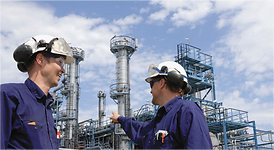
Özlem Academy Education Consultancy Inc.
CONTACT US FOR YOUR QUESTIONS
Address : Tatlısu Mah. Pakdil Sok. PERSPECTIVE Plaza No:5 Floor:1 Flat:3, Şerifali Cd., 34774 Umraniye/Istanbul
Tel Office: +90 (216) 594 55 25
Mobile: +90 (533) 380 83 72

Our services
MAPPING CORROSION MECHANISMS
(API 571 and NACE ATLAS)
CORROSION RISK ASSESSMENT
(API 580, API 581)
Improve and Secure Your Industrial Processes!
Corrosion Mechanisms Extraction and Mapping - Why Us?
Customer Satisfaction is Our Priority!
We offer a critical service to improve the safety and efficiency of industrial facilities - Corrosion Mechanisms Extraction and Mapping. So, why should you choose us?
1. Experience and Expertise: With years of experience, we specialize in extracting and mapping corrosion mechanisms. Our engineers, corrosion experts and technical team ensure full compliance with industry standards and best practices.
2. Customized Solutions: Every plant is unique and corrosion risks can vary. We analyze each project in detail and offer customized solutions. We offer a tailor-made approach.
3. Fast and Efficient Service: Corrosion damage can require rapid response. With our rapid response capability, we minimize problems and help you maintain business continuity.

CORROSION MECHANISMS EXTRACTION AND MAPPING (API 571 and NACE ATLAS)
CORROSION RISK ASSESSMENT (API 580, API 581)
We Prepare in the Best Way.
""Audit and Secure Your Processes!"
Corrosion Mechanisms Extraction and Mapping - Why Us?
Customer Satisfaction is Our Priority!
We offer a critical service to improve the safety and efficiency of industrial facilities - Corrosion Mechanisms Extraction and Mapping. So, why should you choose us?
1. Experience and Expertise: With years of experience, we specialize in extracting and mapping corrosion mechanisms. Our engineers, corrosion experts and technical team ensure full compliance with industry standards and best practices.
2. Customized Solutions: Every plant is unique and corrosion risks can vary. We analyze each project in detail and offer customized solutions. We offer a tailor-made approach.
3. Fast and Efficient Service: Corrosion damage can require rapid response. With our rapid response capability, we minimize problems and help you maintain business continuity.
What is Corrosion?
Corrosion is the loss of material as a result of chemical and electrochemical reactions between the material and its environment. All building materials can be subjected to direct or indirect corrosion. However, corrosion is a slow progressive type of structural damage that especially affects metals.
Why Understanding Damage Mechanisms is Important
The corrosion damage mechanism is a mechanical or chemical process that causes equipment damage or material degradation.
API RP 584 expresses this best:
"In today's operating environment, it is not sufficient to base future inspection plans solely on previously recorded/known equipment condition history. A basic understanding of process/operational conditions and the resulting damage mechanisms is essential to establish and maintain an inspection program that is most likely to detect potential damage."
Damage mechanisms need to be properly identified and understood to determine damage location (general or local), damage propagation rates and mitigation opportunities.
Related Standards and Guidelines:
-API has published API Recommended Practice 571 and ASME, NACE Corrosion Damage Mechanism Atlas to provide guidelines to assist personnel and engineers performing inspections of equipment to identify potential causes of damage.
The -API 571-2020 standard includes a total of 67 damage mechanisms, damage mechanisms commonly seen in various industries, including refining and petrochemicals, flowing fuel, chemical storage and utilization, pulp and paper, etc.
-Corrosion Engineering Handbooks such as ASME, NACE corrosion Atlas, AIChE, BSI, McGraw-Hill etc... are also available.
For example, the ASME, NACE Corrosion Damage Mechanism Atlas (National Association of Corrosion Engineers) identifies 850 corrosion service-induced damage and deterioration mechanisms, including corrosion and other types of metallurgical damage that are most likely to affect the condition of materials.
How is corrosion mechanisms extraction and mapping service performed?
A corrosion mechanisms extraction and mapping service is a process that includes a range of activities required to detect, manage and prevent damage caused by corrosion in industrial facilities. This service is typically carried out by materials engineers, corrosion specialists and plant operators. The basic content of the service is given below:
Facility Review: The first step involves a general inspection of the industrial plant. This is the process of understanding the type of plant, size, materials used and operating conditions. This information is used to identify areas potentially affected by corrosion.
Identification of Corrosion Mechanisms: The mechanisms of corrosion can be caused by different chemical, physical or environmental factors. Identifying these mechanisms is important to understand which type of corrosion is involved. This helps to understand how corrosion occurs.
Assessment of Corrosion Damage: The extent and severity of corrosion damage to equipment and structures within the facility is assessed. The extent of damage helps determine the need for repair or replacement.
Measurements and Data Collection: Measurements are taken to determine the extent, depth and distribution of corrosion damage. This may include a detailed inspection of sensitive equipment and structure.
Mapping and Reporting: The locations of corrosion damage within the facility are mapped and reported. These maps show which areas require immediate attention and which areas require regular maintenance. Reports include the causes of corrosion and proposed solutions.
Developing Corrosion Control Strategies: Strategies are developed to control corrosion. These strategies include measures to prevent, monitor and manage corrosion. This may include material selection, coating applications and regular maintenance.
Documentation and Monitoring: Data obtained during the process of extracting and mapping corrosion mechanisms is regularly updated and monitored. This helps to monitor the long-term performance of the plant.
This service is critical to improve the safety and efficiency of the plant. Early detection and effective management of corrosion mechanisms is essential for the sustainability of industrial plants.

Employer's Obligation to Take Action
Regulation on Preventing Major Industrial Accidents and Reducing Their Effects
Article 6:
General Obligation of the Operator
The operator is obliged to take all necessary measures to prevent major accidents and, in cases where it cannot be prevented, to limit their effects in a way that causes the least damage to the environment and people.









